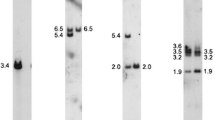Abstract
The chromosomes of the Indian muntjac (Muntiacus muntjak vaginalis) are unique among mammals due to their low diploid number (2N=6♀, 7♂) and large size. It has been proposed that the karyotype of this small Asiatic deer evolved from a related deer the Chinese muntjac (Muntiacus reevesi) with a diploid chromosome number of 2n= 46 consisting of small telocentric chromosomes. In this study we utilized a kinetochore-specific antiserum derived from human patients with the autoimmune disease scleroderma CREST as an immunofluorescent probe to examine kinetochores of the two muntjac species. Since CREST antiserum binds to kinetochores of mitotic chromosomes as well as prekinetochores in interphase nuclei, it was possible to identify and compare kinetochore morphology throughout the cell cycle. Our observations indicated that the kinetochores of the Indian muntjac are composed of a linear beadlike array of smaller subunits that become revealed during interphase. The kinetochores of the Chinese muntjac consisted of minute fluorescent dots located at the tips of the 46 telocentric chromosomes. During interphase, however, the kinetochores of the Chinese muntjac clustered into small aggregates reminiscent of the beadlike arrays seen in the Indian muntjac. Morphometric measurements of fluorescence indicated an equivalent amount of stained material in the two species. Our observations indicate that the kinetochores of the Indian muntjac are compound structures composed of linear arrays of smaller units the size of the individual kinetochores seen on metaphase chromosomes of the Chinese muntjac. Our study supports the notion that the kinetochores of the Indian muntjac evolved by linear fusion of unit kinetochores of the Chinese muntjac. Moreover, it is concluded that the evolution of compound kinetochores may have been facilitated by the nonrandom aggregation of interphase kinetochores in the nuclei of the ancestral species.
Similar content being viewed by others
References
Bloom KS, Fitzgerald-Hayes M, Carbon J (1983) Structural analysis and sequence organization of yeast centromeres. Cold Spring Harbor Symp Quant Biol 47:1175–1185
Brenner S, Pepper D, Berns MW, Tan E (1981) Kinetochore structure, duplication, and distribution in mammalian cells: Analysis by human autoantibodies from scleroderma patients. J Cell Biol 91:95–102
Brenner SL, Huber MH, Brinkley BR (1983) Kinetochore arrangements and associations in mammalian meiosis and spermiogenesis. J Cell Biol 97:189 a
Clark L, Carbon J (1980) Genomic substitutions of centromeres in Saccharomyces cerevisiae. Nature 305:23–38
Comings DE, Okada TA (1970) Whole mount electron microscopy of the centromere region of metacentric and telocentric chromosomes. Cytogenetics 9:436–449
Fitzgerald-Hayes M, Clark L, Carbon J (1982) Nucleotide sequences comparisons and functional analysis of yeast centromere DNA. Cell 29:235–244
Hsu TC, Mead RA (1969) Mechanisms of chromosomal changes in mammalian specialization. In: Benirschke K (ed) Comparative mammalian cytogenetics. Springer Verlag, New York, pp 8–17
Hsu TC, Cooper JEK, Mace ML, Brinkley BR (1971) Arrangement of centromeres in mouse cells. Chromosoma 34:73–78
John B, Hewitt GM (1966) Karyotype stability and DNA variability in the acrididae. Chromosoma 20:155–172
Marks GE (1957) Telocentric chromosomes. Am Nat 91:223–232
Matthey R (1973) The chromosome formulae of eutherian mammals. In: Chiarelli AB, Capanna E (eds) Cytotaxonomy and vertebrate evolution. Academic Press, London, pp 531–553
Merry DE (1983) In vitro karyotypic evolution of the Indian muntjac, Muntiacus muntjac vaginalis. Thesis. Houston Graduate School of Biomedical Sciences, Houston, Texas, pp 1–113
Moroi Y, Peebles C, Fritzler MJ, Steigerwald J, Tan EM (1980) Autoantibody to centromere (kinetochore) in scleroderma sera. Proc Natl Acad Sci USA 77:1627–1631
Peterson JE, Ris H (1976) Electron microscopic study of the spindle and chromosome movement in the yeast Saccharomyces cerevisiae. J Cell Sci 22:219–242
Roos VP (1973) Light and electron microscopy of rat kangaroo cells in mitosis. II. Kinetochore structure and function. Chromosomal: 195–220
Schmidtke J, Brennecke H, Schmid M, Neitzel H, Sperling K (1981) Evolution of muntjac DNA. Chromosoma 84:187–193
Shi L, Ye Y, Duax X (1980) Comparative cytogenetic studies on the red muntjac, Chinese muntjac and their F1 hybrids. Cytogenet Cell Genet 26:22–27
Southern DI (1969) Stable telocentric chromosomes produced following centric misdivision in Myrmeleotettix maculatus (Thumb). Chromosoma 26:140–147
Todd NB (1975) Chromosomal mechanisms in the evolution of artiodactyls. Paleobiology 1:175–188
Wurster DH, Benirschke K (1970) Indian muntjac, Muntiacus muntjac: A deer with a low diploid chromosome number. Science 168:1364–1366
Wurster DH, Atkin NB (1972) Muntjac chromosomes. A new karyotype for Muntiacus muntjac. Experientia 28:972–973
Author information
Authors and Affiliations
Rights and permissions
About this article
Cite this article
Brinkley, B.R., Valdivia, M.M., Tousson, A. et al. Compound kinetochores of the Indian muntjac. Chromosoma 91, 1–11 (1984). https://doi.org/10.1007/BF00286479
Received:
Issue Date:
DOI: https://doi.org/10.1007/BF00286479




